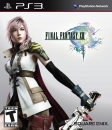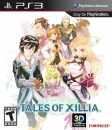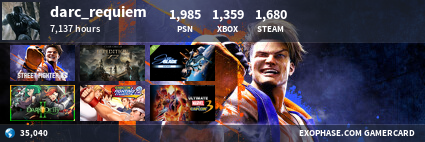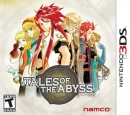Before you scroll to the bottom and just read the score. I scored it poorly based on how I felt but I also put a lot of detail in the review and why I scored it the way I did. Might not be the same score you would have given it, but hopefully through the review you can see why. Didn't bash the game though.
I also decided to put how I personally rate games so just want you guys to read this. The 1-10. 99% of games that are reviewed by journalists are rated 60+, so what's the point in a 10 point system if they're only going to use the upper half? So inflate the scores a little if you want to see something that would more closely resemble what journalists give, but maybe I didn't like the game so a low score would be a higher score, but still low.
http://gamrconnect.vgchartz.com/post.php?id=5834647
--
One Christmas, my brother and I received Final Fantasy as one of our Nintendo games. I didn't play it until after he finished it and no longer played it, but my experience with Dragon Warrior made me fall in love with this game and before I got a SNES, I played through the game a good many times. It wasn't until I got my SNES and then later saw Final Fantasy 4, named Final Fantasy 2, and asked my parents to get me that and from that point I've been a fan of the series. The series has always had its highs and lows, but in the US, even the lows were pretty high. In the past decade the brand has got pretty bad. I've previously played Final Fantasy 13, but quit after putting seven hours in, so recently restarted it and have played it to completion.
I'll first get it out of the way that I didn't like the game, but there are some things that I think are kind of good, but also have noticeable problems. The first of which is a major complaint, but not my least favorite. The 20 hour hallway. Many games have you following a straight path and there are some good qualities about this style of progression. With a linear progression system, you'll never be stuck about finding out where to go, you'll always be progressing towards the action, etc. There's a problem with it though as JRPGs has always been about some semblance of exploration. The other problem amlost the entirety of the first 20 hours is a tutorial or getting used to the combat system, and the storyline is terrible.
Since I've already already alluded to it, what happens after that 20 hours? You get sort of a world map. Not really, but it's the first explorable area of a few that are in the game, all of which are in close proximity. You hear about it in the story, Gran Pulse. When you first get to this area, you see a cutscene of a beautiful looking landscape, various creatures running about, and when you're in control, it's the exact same. The enemies are all preset to be in certain spots, and some of them are set to be able to see much further in the distance than others, but gives off the impression that it's a living world. I didn't do much questing or exploring here, but that is the possibility.
The story of the game is easily the worst part about it. At the beginning you'll be confused and have no idea what anyone is talking about, but basically, the characters are turned into L'cie and they're no longer considered human. The Fal'cie are machine like entities who control the L'cie and there are different L'cie depending on where you're at. There's are some twists to build the plot towards a central point, but in short, the story is garbage. The characters on the other hand are actually likeable, well, almost all of them(Hope,) and while you might not like some or like some better than others, there are parts in the game thrown in the game where you'll get to see characters personalities outside of what they act like the majority of the game. None of them are my favorite characters, but they're likeable enough.
With Square Enix trying to create a unique gameplay style with each new game they release, they've created a paradigm class system. There are six classes in the game, each having a completely different use, Commandos are your attackers, Ravagers are your black mages, Medics are your white mages, Sentinels are your tanks, Saboteurs for your debuffs, and Synergists for your buffs. Each character will eventually be able to use three main classes and in the future all six. While they have the ability to use all six late game, the three that they're not proficient in will require a ridiculous amount of CP to level, so most players will probably use each characters main three only.
Each enemy has a stagger meter that starts at 100% and goes to 999%, meaning that counter is multiplied and added to your damage. If you break the enemy, it adds a large number to that percentage and each hit will increase the percentage faster, some enemies also lose resistances of certain types and gain other resistances(attack or magic.) The meter will drain if an attack or skill attempts to effect an enemy, and it will drain back to 100% once they're staggered. Commandos might deal physical damage and take more off certain enemies, but they add almost no percentage to the stagger meter, but each attack slows down the speed at which the meter will drain. Ravagers add a high amount of percentage but will also quicken the speed at which it drains. Saboteurs add an amount between the Commandos and Ravagers, and the speed it drains is about half.
You'll want to set up your paradigms so you can choose which ones will benefit you the most at the time as you progress, using paradigm shift to change which one you'll want to use at that moment. With three party members, one of your paradigms being a commando, ravager, ravager would be good to keep the drain speed slow while increasing percentage, while you could change to an all ravager team to increase the percentage quickly when you know it can't drop to 100% or after they're broken to boost the amount of percentage and then switch to maybe an all commando team if that is what does the most damage(bosses only as multiple commandos attack different targets.) It's not worth it to buff and debuff enemies in all battles, because sometimes it's best to try and get the battle over with quickly before your overwhelmed, but against tough enemies, they can be the reason between winning and losing. When broken, if an enemy can be affected by a debuff it will work 100%, so use that to your advantage as well. You might also want something set up as sentinel, medic, medic, so the sentinal can provoke enemies and take hits while your medics fully restore your party.
Now as deep as the battle system may seem, it's something that I like and hate about the game. You might argue that I'll go and play the original Final Fantasy and all that I'm doing with my fighter is attacking, with my red mage maybe switching over to magic once and awhile and that's what you're also doing here, which is true. But the majority of the time you're picking the correct paradigm, switching back and forth sometimes even to get the most out of your classes(as the ATB will increase in the background under that paradigm) and during that you're more than likely just mashing auto battle unless the ai has issues with what you're doing, like casting brave three times then faith three times instead of casting them both together. It instead feels like if I was sitting down watching a friend play Final Fantasy for me and I was just telling my friend what to do.
Some additional problems with the combat system. Now as a character, I like Sazh, and he's the only one who has haste for the majority of the game. As a commando and ravager though, Sazh has way slower animations for his attacks than any other character. The ATB gain stops completely while any command is in progress, and with the speed of his attacks, the bonus you get from haste for both other characters almost doesn't even matter. Another thing is that every time you first use the paradigm shift, they want it to look flashy, showing a class up of each character, wasting plenty of time that you could have used choosing your commands, or if your ATB is full in that specific paradigm, wasting precious time that you could just use the skills that second.
Leveling up your stats and gaining abilities is through the Chrystarium System. Think Final Fantasy 10's sphere grid, except all graphically enhanced and not very fun to actually level up. If you've skipped something back in the crystarium, getting back to a previous level is cumbersome, leveling up is also cumbersome and very slow. The crystarium system is better than upgrading your equipment though. Money in this game is quite rare, as unless you sell drops you won't get any, and if you get to Gran Pulse without taking advantage of really easy enemies in early chapters that give you money drops or good equipment upgrades, you won't be doing much upgrading. When upgrading you use beast drops to increase a low amount of points, but increase the percentage each item will give the weapon up to three times, while metallic type items gives you a lot of points but lowers the multiplier afterwards. With little money at the end and good metallic drops harder to get than early chapters, you might just get fed up with the sysstem and just stop upgrading.
Now I mentioned above Gran Pulse and that I didn't do much questing or exploring. The thing about the games first 20 hours is that it's incredibly easy. You'll go all the way through and maybe die only a few times. You'll get to Gran Pulse and most enemies are a good challenge, but some will destroy will. Now I didn't bother with the quests and went straight where I was supposed to go, and I'll say this. Square Enix should have made questing or atleast grinding in this area mandatory or atleast given a hint that if you didn't grind you'd have to walk all the way back here to do so.
While at first I didn't like the battle music, got to the point where I didn't mind it, and the rest of the music in the game is really good. The graphics in the beginning felt like they were pretty poorly done for a game that released in 2010, and the character models which it seems that most of their time was spent in working on have a lot of flat edges. You'll see so many flat edges instead of a curve in a characters body part, clothes, etc when when not looking at them face on. Many scenes in the game the characters have rectangular fingers. Very good textures though. Dungeons have an extremely cheap metallic looking feel in a lot of them early game, and the entire dungeon is a lot of the same. Once you get closer to the end of the game, the dungeons actually look good, Grand PUlse and beyond, but while the dungeon in chapter 12 looks very good and a lot's going on, the games framerate has very noticeable drops.
Anyways, I think the game was pretty poorly done on most accounts. Poor story. Battle system that had unique concepts but it felt like Square Enix was really trying to make an RPG that played like an action game, what with the flashy attacks, spells like Fira, etc, being area of effect, enemies moving out of the way of your attacks, and other such things instead of doing the logical thing and creating an action RPG. I think they would have done a lot better by doing that in the first place, but instead it took them three times and they're Lightning Returns which looks amazing. Lightning Returns is the reason I'm replaying through Final Fantasy 13 and will later play through Final Fantasy 13-2.
Gameplay - 6
Design - 1
Presentation - 3
Balance - 4
Overall - 3.5




































































